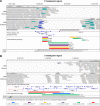Clinical and genetic characterisation of dystrophin-deficient muscular dystrophy in a family of Miniature Poodle dogs
- PMID: 29474464
- PMCID: PMC5825102
- DOI: 10.1371/journal.pone.0193372
Clinical and genetic characterisation of dystrophin-deficient muscular dystrophy in a family of Miniature Poodle dogs
Abstract
Four full-sibling intact male Miniature Poodles were evaluated at 4-19 months of age. One was clinically normal and three were affected. All affected dogs were reluctant to exercise and had generalised muscle atrophy, a stiff gait and a markedly elevated serum creatine kinase activity. Two affected dogs also showed poor development, learning difficulties and episodes of abnormal behaviour. In these two dogs, investigations into forebrain structural and metabolic diseases were unremarkable; electromyography demonstrated fibrillation potentials and complex repetitive discharges in the infraspinatus, supraspinatus and epaxial muscles. Histopathological, immunohistochemical and immunoblotting analyses of muscle biopsies were consistent with dystrophin-deficient muscular dystrophy. DNA samples were obtained from all four full-sibling male Poodles, a healthy female littermate and the dam, which was clinically normal. Whole genome sequencing of one affected dog revealed a >5 Mb deletion on the X chromosome, encompassing the entire DMD gene. The exact deletion breakpoints could not be experimentally ascertained, but we confirmed that this region was deleted in all affected males, but not in the unaffected dogs. Quantitative polymerase chain reaction confirmed all three affected males were hemizygous for the mutant X chromosome, while the wildtype chromosome was observed in the unaffected male littermate. The female littermate and the dam were both heterozygous for the mutant chromosome. Forty-four Miniature Poodles from the general population were screened for the mutation and were homozygous for the wildtype chromosome. The finding represents a naturally-occurring mutation causing dystrophin-deficient muscular dystrophy in the dog.
Conflict of interest statement
Figures






Similar articles
-
Dystrophin-deficient muscular dystrophy in a Norfolk terrier.J Small Anim Pract. 2015 May;56(5):351-4. doi: 10.1111/jsap.12292. Epub 2014 Oct 29. J Small Anim Pract. 2015. PMID: 25353637
-
A novel canine model for Duchenne muscular dystrophy (DMD): single nucleotide deletion in DMD gene exon 20.Skelet Muscle. 2018 May 29;8(1):16. doi: 10.1186/s13395-018-0162-1. Skelet Muscle. 2018. PMID: 29843823 Free PMC article.
-
Canine X-linked muscular dystrophy in a family of Grand Basset Griffon Vendéen dogs.J Comp Pathol. 2007 Nov;137(4):249-252. doi: 10.1016/j.jcpa.2007.06.007. Epub 2007 Sep 21. J Comp Pathol. 2007. PMID: 17888939
-
Canine X-linked muscular dystrophy as an animal model of Duchenne muscular dystrophy: a review.Am J Med Genet. 1992 Feb 1;42(3):352-6. doi: 10.1002/ajmg.1320420320. Am J Med Genet. 1992. PMID: 1536178 Review.
-
Skipping multiple exons of dystrophin transcripts using cocktail antisense oligonucleotides.Nucleic Acid Ther. 2014 Feb;24(1):57-68. doi: 10.1089/nat.2013.0451. Epub 2013 Dec 31. Nucleic Acid Ther. 2014. PMID: 24380394 Review.
Cited by
-
X-Linked Duchenne-Type Muscular Dystrophy in Jack Russell Terrier Associated with a Partial Deletion of the Canine DMD Gene.Genes (Basel). 2020 Oct 8;11(10):1175. doi: 10.3390/genes11101175. Genes (Basel). 2020. PMID: 33049940 Free PMC article.
-
The Dog Model in the Spotlight: Legacy of a Trustful Cooperation.J Neuromuscul Dis. 2019;6(4):421-451. doi: 10.3233/JND-190394. J Neuromuscul Dis. 2019. PMID: 31450509 Free PMC article.
-
Sarcoglycan A mutation in miniature dachshund dogs causes limb-girdle muscular dystrophy 2D.Skelet Muscle. 2021 Jan 7;11(1):2. doi: 10.1186/s13395-020-00257-y. Skelet Muscle. 2021. PMID: 33407862 Free PMC article.
-
X-linked muscular dystrophy in a Labrador Retriever strain: phenotypic and molecular characterisation.Skelet Muscle. 2020 Aug 7;10(1):23. doi: 10.1186/s13395-020-00239-0. Skelet Muscle. 2020. PMID: 32767978 Free PMC article.
-
Current Classification of Canine Muscular Dystrophies and Identification of New Variants.Genes (Basel). 2023 Jul 29;14(8):1557. doi: 10.3390/genes14081557. Genes (Basel). 2023. PMID: 37628610 Free PMC article.
References
-
- Koenig M, Monaco AP, Kunkel LM. The complete sequence of dystrophin predicts a rod-shaped cytoskeletal protein. Cell. 1988;53(2):219–28. . - PubMed
-
- Mendell JR, Shilling C, Leslie ND, Flanigan KM, al-Dahhak R, Gastier-Foster J, et al. Evidence-based path to newborn screening for Duchenne muscular dystrophy. Annals of neurology. 2012;71(3):304–13. doi: 10.1002/ana.23528 . - DOI - PubMed
-
- Caskey CT, Nussbaum RL, Cohan LC, Pollack L. Sporadic occurrence of Duchenne muscular dystrophy: evidence for new mutation. Clin Genet. 1980;18(5):329–41. . - PubMed
-
- Nowak KJ, Davies KE. Duchenne muscular dystrophy and dystrophin: pathogenesis and opportunities for treatment. EMBO Rep. 2004;5(9):872–6. doi: 10.1038/sj.embor.7400221 ; PubMed Central PMCID: PMCPMC1299132. - DOI - PMC - PubMed
-
- Hoffman EP, Brown RH Jr., Kunkel LM. Dystrophin: the protein product of the Duchenne muscular dystrophy locus. Cell. 1987;51(6):919–28. . - PubMed
Publication types
MeSH terms
Substances
LinkOut - more resources
Full Text Sources
Other Literature Sources
Miscellaneous

